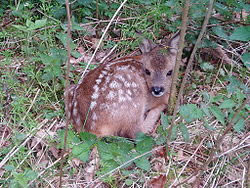Roe Deer

Facts about creatures
- Home
- Animal Classification
- Animal Habitats
- Amphibians
- Arthropods
- Bats
- Birds
- Carnivorans
- Cetaceans
- Chordates
- Crustaceans
- Dinosaurs
- Diprotodonts
- Elephants
- Fish
- Golden Mole
- Insects
- Lagomorphs
- Mammals
- Mammal Teeth
- Marsupial Mole
- Metamorphosis
- Mollusks
- Primates
- Reptiles
- Rodents
- Ruminants
- Soricomorphans
- Tenrec
- Tetrapods
- Vertebrates
Roe Deer
The roe deer is a relatively small deer that can be found in forests throughout Europe.
It is sometimes seen in grasslands.
An adult roe deer is usually between 3 and 4 ½ feet long, with a shoulder height of between 2 and 2 ½ feet.
It has a reddish body and a grey face.

Roe deer can be difficult to spot.
If a roe deer is suspicious, it will remain motionless against the forest background.
It will only bound away if it is sure that it has been seen.
A roe deer can cover as much as 17 yards in a single jump.
As it leaps away, it will reveal a patch of light-colored hair on its rump. It can pump up this hair as an alarm signal to other roe deer.
A roe buck (adult male) usually has antlers with three branches, or points, on each side, making six points in all. They may be as much as a foot long in total.
When the antlers are growing, in the beginning of the year, they are covered in velvet (furry skin).

Once the antlers are fully grown, they harden. The velvet dies. The buck rubs the velvet off by scraping his antlers up and down a tree, an activity known as fraying.
Unlike larger breeds of deer, roe do not usually form herds. Instead, they live on their own or in small groups.
They will congregate in winter, when food is confined to limited areas.
Diet
Roe deer are ruminants – cud-chewing mammals.
They generally feed between dawn and dusk.
In between those times, they will rest and ruminate (chew their cud.)
They will feed and ruminate all day long in undisturbed areas.
A roe deer’s diet includes leaves, twigs, grass, conifer needles, herbs and mushrooms.
Territory
The doe (adult female) and buck each have their own territories from about April to August. Does’ territories may overlap with the territories of bucks.
Does may also share their territories with other does.
Bucks do not share their territories.
A buck will put on aggressive displays to defend his territory from other bucks. During these displays, he will bark, fray and use his forefeet to scrape up moss and leaves.
In the summer, evenly matched bucks will fight. Fights usually consist of pushing matches, with the loser bounding away.
Sometimes, however, males will fight to the death. The winner will stab the loser repeatedly, even after the loser has fallen.
Reproduction and Childhood
The roe deer’s mating season, or rut, takes place in between late July and early August.
The fertilized egg of a doe does not immediately implant itself in the uterus. Instead, it floats freely as it slowly becomes larger.
It becomes implanted in the uterus in December.
Fawns (young deer) are born in between lat May and early June of the following year.
Does usually give birth to twins. Sometimes triplets are born.
If there is little food available, a doe will give birth to only one fawn.
Fawns are born with spotted coats that help to camouflage hem.
They develop normal adult coats by the time they are about three months old.
In December of their first year, male fawns sometimes grow tiny spikes or buttons of antler, which become hard by January. They shed these antlers in February, and then grow normal antlers.